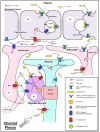Iron, neuro-bioavailability and depression
- PMID: 35846210
- PMCID: PMC9175715
- DOI: 10.1002/jha2.321
Iron, neuro-bioavailability and depression
Abstract
Medical management of iron deficiency (ID) requires to consider its consequences in biochemical and physiological plural functions, beyond heme/hemoglobin disrupted synthesis. Fatigue, muscle weakness, reduced exercise capacity, changes in thymia and modified emotional behaviors are the commonest symptoms integrated in the history of ID, dependent or not of the hemoglobin concentration. The relationship between depression and absolute ID (AID) is a condition which is often unrecognized. Neuro-bioavailability and brain capture of blood iron are necessary for an appropriate synthesis of neurotransmitters (serotonin, dopamine, noradrenaline). These neurotransmitters, involved in emotional behaviors, depend on neuron aromatic hydoxylases functioning with iron as essential cofactor. Noradrenaline also has impact on neuroplasticity via brain-derived neurotrophic factor (BDNF), which is key for prefrontal and hippocampus neurons playing a role in depression. Establishing the formal relationship between depression and AID remains difficult. Intracerebral reduced iron is still hard to quantify by neuroimaging and single-photon emission computed tomography (SPECT) now tends to explore the neurotransmission pathways. AID has to be looked for and identified in the context of depression, major episode or resistant to conventional treatment such as serotonin reuptake inhibitor, and even in the absence of anemia, microcytosis or hypochromia (non-anemic ID). Confronted to brain imaging, blood iron status evaluation is indicated, especially in depressed, treatment-resistant, iron-deficient young women. In patients suffering from depression, increase in the prevalence of AID should be considered, in order to deliver a suitable treatment, considering both anti-depressive program and iron supplementation if AID.
Keywords: deficiency; depression; iron; neuro‐availability.
© 2021 The Authors. eJHaem published by British Society for Haematology and John Wiley & Sons Ltd.
Conflict of interest statement
The authors declare no conflict of interest.
Figures



References
-
- Dugan C, MacLean B, Cabolis K, Abeysiri S, Khong A, Sajic M, et al. The misogyny of iron deficiency. Anesthesia 2021;76(Suppl 4):56–62.
-
- Lopez A, Cacoub P, Macdougall IC, Peyrin‐Biroulet L. Iron deficiency anaemia. Lancet North Am Ed. 2016;387(10021):907–16.
-
- Pasricha SR, Tye‐Din J, Muckenthaler MU, Swinkels DW. Iron deficiency. Lancet North Am Ed. 2021;397(10270):233–48.
-
- WHO . Prevalence of anaemia in women. https://apps.who.int/gho/data/node.main.ANAEMIAINWOMENANDCHILDREN?lang=en. Accessed 19 April 2021.
-
- Musallam KM, Taher AT. Iron deficiency beyond erythropoiesis: should we be concerned? Curr Med Res Opin. 2018;34(1):81–93. - PubMed
Publication types
LinkOut - more resources
Full Text Sources
